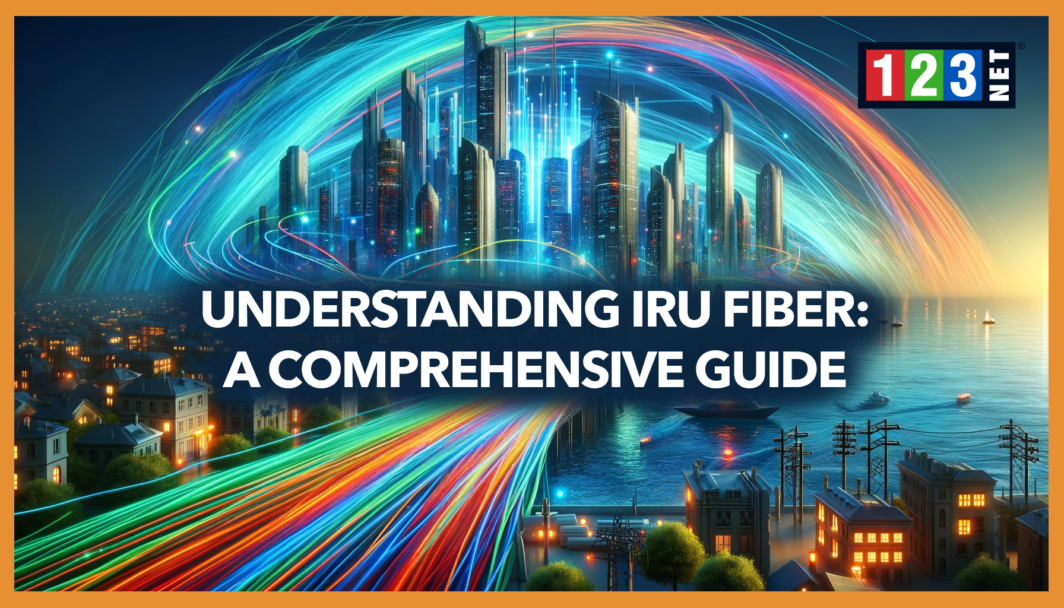
Introduction
Indefeasible Right of Use (IRU) is a term that resonates deeply within the telecommunications industry. An IRU is a permanent contractual agreement that grants the buyer an unchallengeable right to use a specified portion of a fiber-optic cable’s capacity for a predetermined period. This concept, pivotal for the global telecommunications infrastructure, ensures the efficient and secure transmission of data across vast distances. From submarine communications cables stretching across oceans to the intricate networks of fiber-optic cables that crisscross continents. IRUs play a crucial role in the backbone of modern communication systems.
The Concept of IRU in Fiber Optics
Expenses and Operational Challenges
The advent of Indefeasible Right of Use (IRU) agreements heralded a transformative phase in the telecommunications sector. It is addressing the formidable expenses and operational challenges. They are tied to the augmentation of network capacities. These agreements surfaced as a tactical maneuver for telecom entities to monetize their dormant infrastructure. Thereby leasing out surplus bandwidth to other parties. Such strategic deployment not only enhanced the efficiency of network utilization but also engendered a revenue conduit.
Financial Commitments
The significance of IRU agreements is especially pronounced in the domain of submarine and undersea cables. These oceanic conduits, pivotal for intercontinental communication, entail hefty financial commitments for their construction and upkeep. The inception of IRU agreements allowed cable proprietors to ameliorate some of these financial burdens by pre-selling bandwidth to interested parties. This model provided a dual advantage: it facilitated the recoupment of construction costs for the cable owners and, concurrently, endowed buyers with indispensable bandwidth access. This access was granted without necessitating them to bear the prohibitive costs associated with laying down new infrastructure.
Moreover, the IRU framework introduced a novel asset class within the telecommunications infrastructure, transforming how bandwidth was commoditized and traded. It enabled a more dynamic and flexible approach to managing telecom resources. This is allowing for a redistribution of financial and operational risks. They are associated with undersea and submarine cable systems. Through IRUs, the telecommunications industry witnessed a paradigm shift, moving towards a more collaborative and economically viable model of infrastructure. This shift not only optimized the global network fabric but also propelled the industry forward by fostering innovation. As well as competition, and accessibility in global connectivity solutions.
Importance of IRU Fiber in Telecommunications
Within the vast and intricate telecommunications ecosystem, Indefeasible Right of Use (IRU) agreements have emerged as a cornerstone. They are underpinning a broad spectrum of services that span from lightning-fast internet connectivity to cross-continental phone communications. These agreements have been instrumental in leveling the playing field. This is allowing smaller telecom operators and various service providers in the market landscape. By availing themselves of the opportunity to lease the requisite network capacity, these entities can bypass the exorbitant financial barrier. It is associated with deploying their own cable infrastructures. This democratization of network access catalyzes a virtuous cycle of competition, leading to reduced service costs for end-users.
Furthermore, IRUs play a pivotal role in bolstering the resilience and dependability of the global communications framework. The strategic distribution of network capacity ownership and usage rights through IRUs introduces a layer of redundancy that is vital for the uninterrupted flow of information. In today’s digital age, where data serves as the backbone of global economies, governance structures, and societal interactions, the importance of such redundancy cannot be overstated. It ensures that the global network can withstand individual failures without succumbing to systemic disruptions. This robustness, facilitated by IRUs, is indispensable in maintaining the continuity of communication services that are critical to the functioning of modern societies. IRUs significantly contribute to the overall strength, efficiency, and innovation within the global communications ecosystem.

Types of IRU Fiber Agreements
IRU agreements can be broadly categorized into two types: Dark Fiber IRU and Capacity IRU. Dark Fiber IRUs pertain to the use of unlit, or inactive, fiber strands within a cable. The buyer is responsible for “lighting” the fiber by installing the necessary equipment to transmit data. This type of IRU offers maximum flexibility and control, making it ideal for organizations with significant data transmission needs.
Capacity IRUs, involve the purchase of a predetermined bandwidth capacity on a fiber-optic cable that is already operational. This option suits entities that require immediate access to telecom capacity without the complexities of managing the physical infrastructure.
Both types of IRUs necessitate a deep understanding of the technical and performance specifications of the fiber-optic system. This is including factors like attenuation, Chromatic Dispersion, Polarization Mode Dispersion, and Optical Return Loss. These specifications ensure that the leased capacity meets the stringent requirements of modern telecommunications.
Technical Specifications and Maintenance
The intricacies of Indefeasible Right of Use (IRU) agreements extend into the realm of technical specifications, setting forth stringent quality and performance benchmarks for the underlying fiber-optic systems. These specifications encompass a variety of parameters critical to the optimal functioning of the network. Attenuation, for instance, quantifies the diminution of signal strength over distance, a vital consideration for maintaining communication efficacy across vast spans. Chromatic Dispersion, impacts the clarity and velocity of transmitted signals. This is by causing different wavelengths to travel at slightly varied speeds. Additionally, Polarization Mode Dispersion and Optical Return Loss are paramount in assessing the transmission’s integrity and efficiency, ensuring that the data conveyed remains undistorted and robust against potential signal return issues.
Equally essential to the IRU framework are the maintenance and restoration clauses, which delineate the cable owner’s duties in preserving the network’s operational dependability. These provisions mandate regular oversight, encompassing inspections, repairs, and necessary enhancements to uphold the system’s performance throughout the IRU’s tenure. The inclusion of shared maintenance costs underscores the cooperative endeavor to safeguard the infrastructure’s enduring functionality. This collaborative financial responsibility not only underscores the mutual investment in the network’s success but also ensures a proactive approach to maintaining high standards of service and reliability, essential for the long-term sustainability of the fiber-optic system.
Financial Aspects of IRU Fiber
Indefeasible Right of Use (IRU) agreements necessitate a considerable financial commitment, primarily due to the substantial upfront costs required for the construction and activation of dark fiber infrastructure. This significant initial investment, however, is counterbalance by the enduring advantages that IRUs offer. Among these benefits is the assurance of bandwidth availability, which is crucial for telecommunications operations. Moreover, the IRU’s potential for resale or its use as collateral introduces a tangible asset into a company’s portfolio. This characteristic is particularly beneficial for businesses aiming to enhance their financial statements, as the expenditure on an IRU is classified as a capital investment, thereby not inflating the operational expenses on the balance sheet.
Furthermore, the structure of IRU agreements typically includes fixed or slightly adjustable maintenance fees, lending a degree of financial predictability and stability to the arrangement. These fees are instrumental in ensuring the continuous, efficient operation of the fiber-optic network, covering routine maintenance, repairs, and any necessary upgrades. By providing for the regular upkeep of the infrastructure, these fees play a pivotal role in protecting the initial investment. They guarantee that the fiber-optic system remains in optimal condition, delivering uninterrupted, high-quality service over the long term. This arrangement not only secures the technological foundation necessary for modern telecommunications but also supports a sustainable economic model for the utilization of fiber-optic networks.
Regulatory and Legal Considerations
The intricate regulatory and legal framework surrounding Indefeasible Right of Use (IRU) agreements is a cornerstone for their successful implementation and operation. Ensuring adherence to both local and international statutes is crucial, particularly for fiber-optic networks that span multiple jurisdictions. This compliance spectrum covers a broad array of requirements, from securing the necessary licenses to gaining access to essential infrastructure. Such regulatory diligence ensures that the deployment and expansion of cross-border fiber-optic systems proceed without legal impediments, safeguarding the interests of all stakeholders involved.
The legal structure of IRU agreements clearly outlines each party’s rights and duties. These contracts cover various scenarios, such as ownership changes, new tech integration, and handling network disruptions. Their detailed nature is crucial for preventing disputes and ensuring the network’s continuous operation. Carefully drafted agreements provide a solid basis for the smooth functioning and expansion of global communication networks, emphasizing the critical importance of legal and regulatory adherence in telecommunications.
Future of IRU and Fiber Optics
The trajectory of IRU and fiber optics is entwining with the burgeoning global demand for bandwidth. A trend propelled by the proliferation of cloud computing, streaming services, and the Internet of Things (IoT). This surge underscores the escalating strategic value of IRU agreements, poised to become even more critical as technological innovations emerge. Developments in fiber materials and transmission methodologies are set to amplify the capabilities and efficiency of fiber-optic networks.
Current market dynamics signal a shift towards network solutions that prioritize flexibility and scalability, with IRUs at the heart of this evolution. These agreements offer a framework that not only accommodates but also anticipates the rapid changes in telecommunications demand and technology. The inherent adaptability and economic structure of IRU agreements render them an indispensable asset for entities aiming to navigate and lead in the dynamic landscape of telecommunications. As the sector continues to evolve, the role of IRUs in facilitating access to advanced, resilient, and scalable network infrastructure. This will undoubtedly become more pronounced, ensuring that companies can meet the challenges and opportunities of the digital age head-on.

FAQs Section
- What is an IRU agreement? A: An Indefeasible Right of Use (IRU) agreement is a legal contract that grants the buyer a permanent right to use a portion of a fiber-optic cable’s capacity for a set period.
- How long do IRU agreements last? A: IRU agreements typically span 20 to 30 years, reflecting the long-term nature of the investment in telecommunications infrastructure.
- Can IRU rights be resold or traded? A: Yes, IRU rights can be resold or traded, offering flexibility and potential financial benefits to the holder. This aspect makes IRUs a valuable asset in the telecommunications industry.




